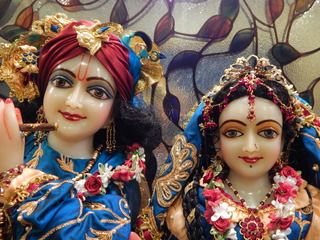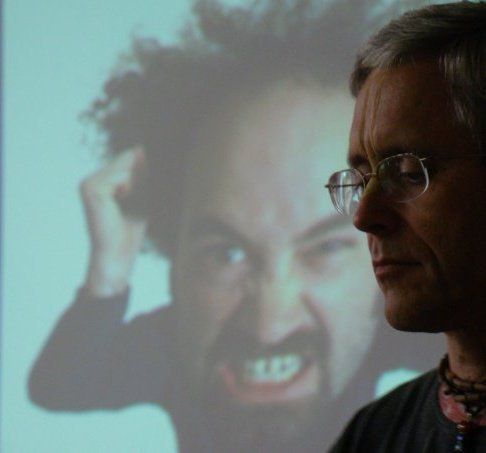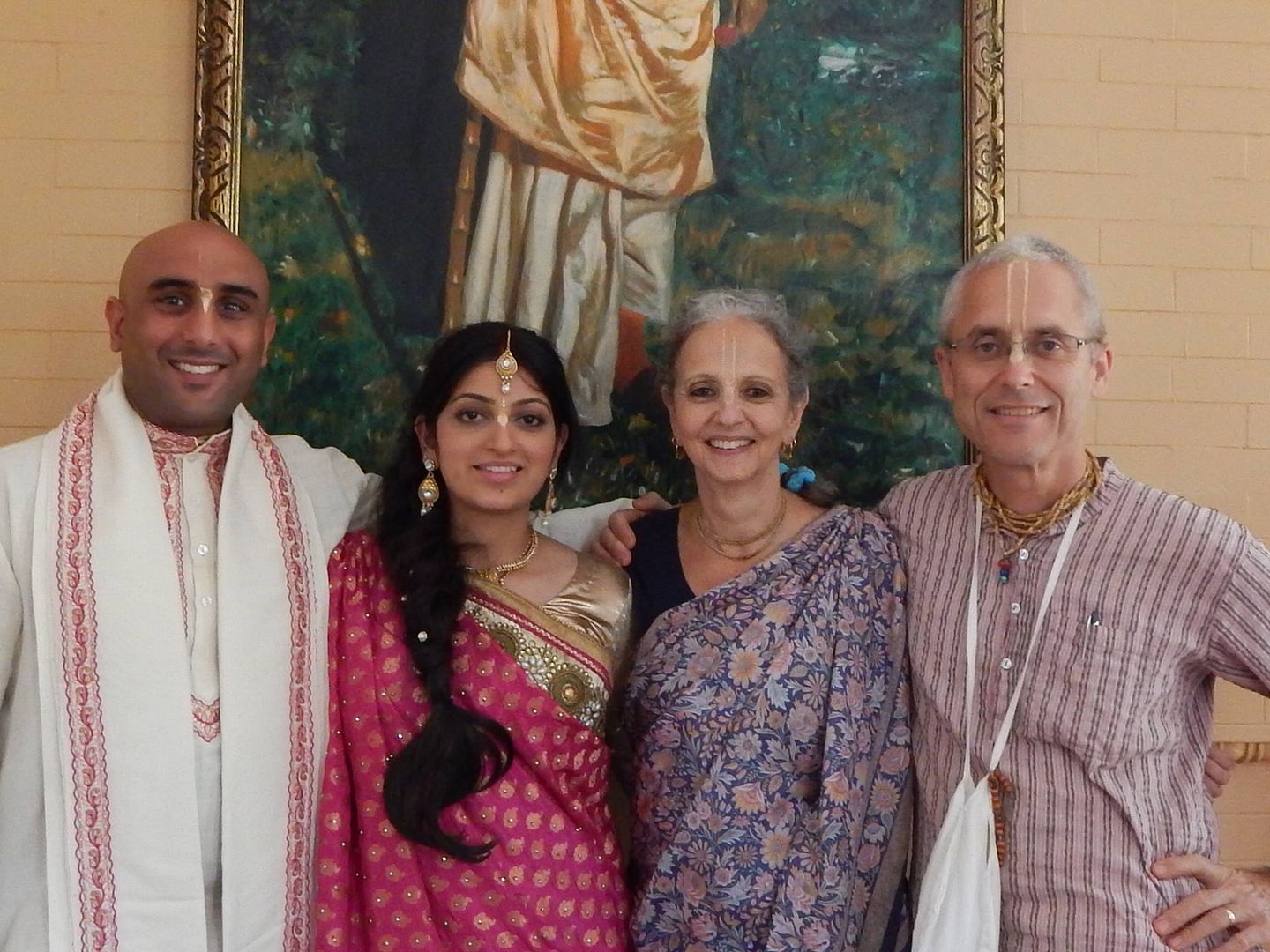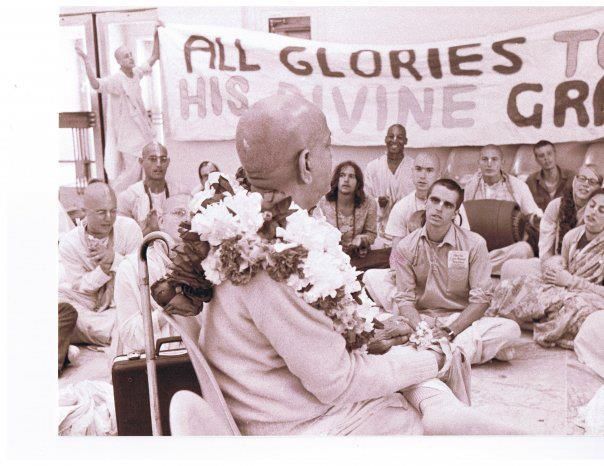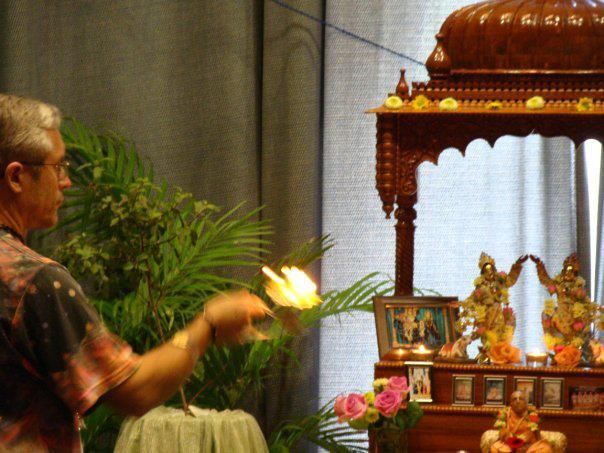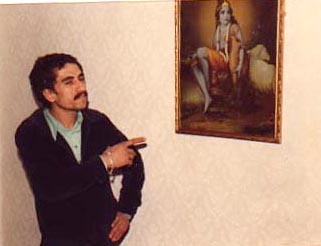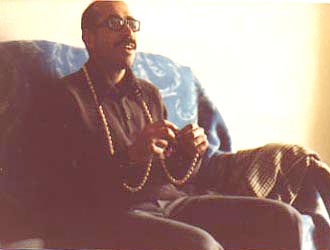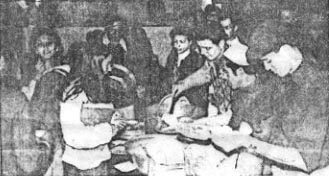A photo of Phalguni Radhika dasi during her wedding ceremony to Deva Madhava das.
By Sri Nandanandana dasa
Based on an
Interview with Felicity O’rourke
(Excerpt from “Mysteries of the Ancient Vedic Empire”)
If we do a comparative study, we can recognize numerous aspects of the Vedic culture, Krishna consciousness, in many of the Native American traditions. In order to show this, I conducted an interview with Felicity O’rourke who is a member of the Anishnaabi Native American tribe. She is now a practicing Vaishnava and disciple of Jayapataka Swami with the initiated name of Phalguni Radhika dasi. This describes many of the similarities she recognizes between Vedic culture and her native American traditions.
She explains: My family did not have a very strong Native American upbringing because my mother’s grandmother was the one who had a lot of the old ancient teachings and the knowledge, which she then taught to my grandfather or my Mom’s father. But she taught it to him in a way that was more of a lifestyle, not like a spiritual practice. And she wouldn’t let him or anyone else in the family know specifics of her native culture because she was ashamed. This was when so many Native Americans were going into boarding schools, or being taken away from their family members. So they, my particular family, hid from that. So there’s actually no physical documentation of my family at all in regards to them being native.
She would say, “You’re native and that’s all you need to know, and I won’t tell you anything else.” And that was it. That’s how my grandfather grew up and how my Mom grew up. So even when they had questions and wanted to ask about the culture, there was nothing, she would not share it. So it was just lost through the family line.
It was decades of my Mom’s searching for who she was, what was her tribe, what were the teachings, all of it she had to research on her own. She found it was most likely we are Anishnaabi. This is an umbrella term for a lot of native people or smaller tribes of natives, and we have not exactly pinpointed from which tribe we came. But it is primarily people who are woodland and lake natives, particularly along the great lakes of Michigan.
What my Mom learned, just from what her father taught her, is just to act as a human being with these traditional native practices. But she had no idea that it was a part of a Native American culture. She just thought is was what her Dad valued as a person, not necessarily in a cultural context.
SACRED FOOD
A lot of her spiritual practices have to do with food, which really struck me when I started to associate with Krishna devotees in Ann Arbor, when I was learning about the process of honoring prasadam, because I had already done most of these things growing up within the native practices. And it started first with every living entity as a spirit soul. This includes plants, which most spiritual practices do not overtly express. At least in most religious organizations, living souls being in plant bodies is not often stated. But this is something we very much value, so much so that we would take a plant and offer a prayer to the plant saying what is my intention, why I am using you, and “I am going to offer you to God first. Then I am going to take you for substance so I can live and continue praying and enlivening my experiences with others. So please accept that I have to take you so we can continue this.”
Then they would take a small shovel, or if they were going to clip the plant, they would tap the plant three times, or tap the shovel to the ground three times, to let the plant know this is it, so be ready. And then they would scoop it or cut it and take the plant or grain and prepare it, and then offer it on a spirit plate.
The spirit plate is the understanding of Wakantanka, a Lokota word. Wakan means all that is great, the highest being, and Tankashala is the spiritual entities. This also translates as Grandfather, or that which is never born and never dies. Wakan is the highest of the spiritual entities–the Great Spirit or God. It is also known as the Great Mystery because many natives no longer see God as an individual person. Although if you read any of the ancient stories, He often is recognized as a man. Some people say it is because of the influence of the black robes (Catholics), and others say it was before them, although it is hard to say due to our history.
Anyway, you take this plate of what you have offered as your food, and you first give it to Wakantanka, and you pray over it. Then you take this sweet grass, which smells very fragrant, and you burn some incense over it, so it is part of an offering. So you are specifically making an environment of spiritual potencies to say, “Please accept this.” Then you take that. And that happens for every meal. Sweet grass is also an invitation or offering to bring the elders. (Also there is the Vedic concept of making an offering to the elders.)
So when I had that experience [in the Native American tradition], I said, “Oh, this is like honoring prasadam. First you offer it to Krishna and then you take it.” I had already done that. So it was really easy for me to step into that place of being appreciative of offering to Krishna and accept Wakantanka as Krishna. This is really great. The whole understanding is that even a blade of grass is a living entity, and every living entity should be honored and respected.
REINCARNATION
Also understood is this cycle of repeated birth and death in my Native American tradition. Reincarnation is definitely there in Native American spirituality. This is why some may have a particular affiliation with certain animal spirit guides because they accept an ancestor became an animal, so now that animal is with you, or following you, or having some sort of relationship with that animal. So then they are helping you through your [life] process. You also, in this way, help other living entities through their process of getting out of this plane [of existence].
A key part of native spirituality is understanding that there are multiple realms. You are in one realm and you are on earth, so that means something, but this is not your permanent location. This is not it. This is why Native American burial grounds and things like that were so important because they understood they wanted to do their proper rituals and ceremonies so the soul could travel peacefully, instead of getting caught or stuck in the material world.
DEATH
Another element, especially for death rites, is that once a person has left their body, then you are not supposed to speak their name for a year. The reason is so they do not feel a desire to come back or stay as a ghost or a subtle living being still attached to their relationships to the people here, or to their own body. So you don’t speak their name for a year so they can make that process all the way through [to the next realm].
That is another understanding of reincarnation, leaving the body, and there are definitely opportunities for a living entity to stay and linger around in a subtle form, which you do not want them to do. You want them to move on to the next or higher position.
THE AGES
In Native American spirituality there is also this understanding of the ages being cyclical. There are similarities with Dvapara-yuga, Kali Yuga, and time keeps going back through a cycle. And there is a color that is designated for those ages. Colors, the symbolic understanding of them, was another big thing that was interesting to me. The ages reflect these moods: White–north, elder; Black–west, middle age; Red–south, youth; Yellow–east, child.
MEDICINE WHEEL
There is also the medicine circle whereas everything happens in a wheel or circle. So there are different ages that are represented by the different colors. So with Krishna appearing in a blackish form or in a reddish form, and these sorts of things are also very similar to Native American spirituality. A cyclical understanding is pretty basic through all the Native American tribes, not just the Anishnaabi or Lokota tribes, though there are some exceptions. But most understand reincarnation, and offering your food, having death rites, etc.
CREMATION
Cremation is also an important factor for most Native American people, to make sure the body is burnt so they [the deceased] can move on, and let the body go back to the land. Though there is a lot of Native American burial grounds, that happened not by the desire of the native people. So that is why there is a lot of curses that happened associated with burial grounds. Most often it was during when there was a lot of slaughter of the people and they were just laid where they dropped. So there were ceremonies performed over those areas. But that can differ depending on the tribe.
CREATION STORIES
Another interesting topic is the creation stories, which are many. But the one I’m most familiar with is where they speak of the different incarnations [of God]. For example, one of the main creation stories is about a turtle, which is like Kurma. I have spoken with my step-Dad, he is a Cherokee native, so he was really surprised by Kurma being an incarnation of Krishna, because that is part of our Native American creation story. There is a cyclical understanding of the earth going in the water and coming back out, and things will happen to the earth and start over again.
So with Kurma and the churning of the milk ocean, that corresponds to when the earth fell and was surrounded by water. So there is a whole story related to that with the significance being on this turtle who brought life back.
DEMIGOD WORSHIP
Almost all Native American practices are based on some sort of demigod worship, like worshiping the moon, and having an understanding that you are worshiping entities on the moon, and the moon is said to be a heavenly planet [Vedically speaking], so there is a similarity to that in Native American spirituality.
Also, different planets have different healing properties. So if you were praying to the sun, there are specific reasons why you pray to the sun in regards to healing. That is more like the Lakota tradition and why they do the Sun Dance ceremony. This is when they dance for four days around an outdoor arena, while taking no food or water. And they pray to the sun, and a tree which is in the center of the arena. Then there is a massive ceremony. But it is essentially prayers and sacrifice for healing of themselves and those they are representing. There is a lot to this.
There is also the women’s moon ceremony. Women are more inclined to worship the moon. So every month they will make prayer ties, or these little bundles, and they will tie it with yellow string and offer it with their hands to the moon, and they will pray to be rejuvenated or revitalized. And they’ll have these little pots of water to see the reflection of the moon.
MYSTIC PRACTICES
There is also a lot of mystic yoga sort of things that happen in Native American spirituality. A lot of it is this understanding of traveling to other planets. Around four or five in the morning, like first dawn, when you can see the north star, they will pray to it, around the same time as mangala arati [in the Vedic culture], and you chant these prayers in this song. By doing that you can travel to other realms or other planets. So they do that pretty regularly, depending on the spiritual practice. I know my Mom has done that on multiple occasions.
Sweat lodge ceremonies are also designed to do that sort of thing. The sweat lodge is considered to work like a space ship wherein you can travel to other realms using your subtle body. Then you can have different kinds of spiritual or physical experiences and bring them back to the people, like visions, etc.
So these are all similar to or part of the Vedic traditions in that they serve similar purposes. There is so much that is nearly identical to the Vedic teachings.
There are also different kinds of plants that are used for specific ceremonies, and there is a living entity who presides over that plant that you are dedicating time and attention to, or prayers for healing or for guidance. This is similar to the Vedic respect for, and our relationship with the tulasi plant. So there is this sort of understanding about plants in Native American spirituality, especially with tobacco, which most Native Americans do not use like an intoxicant, but as a way of offering prayers. In some cases they do smoke tobacco by holding it in their mouth and then releasing it. So they are not utilizing it to get high. There’s this understanding that tobacco is a sacred entity. So instead of using or manipulating it for their own benefit, through prayers they are asking tobacco to help them.
They do the same thing with red willow. Cedar is another plant that they use as very special, like in the fire, or in ceremonies, or for putting around holy places because cedar is a holy plant.
When something serious is happening to the tribe, like a famine or something, someone will go out and give a symbol of sacrifice, like an important possession and offer it into the sacrificial fire, which is huge in Native American spirituality. In a big ceremony, like a Vedic yajna, it is necessary to have a fire and offer things into the fire. Often they will offer valuable possessions into the fire, or maybe their only possessions, knowing it is for the benefit of everyone, or like a reciprocation that they will receive teachings in return. This is why there is a fire in every ceremony. If there is not a fire, then the ceremony cannot happen, or it is incomplete [such as if rainy weather puts out the fire].
So when my family came to my Vedic wedding ceremony, they loved the fire yajna because it is so familiar to them. That is what they do, they offer things into the fire, they have prayer, they have songs, and it is crucial to the ceremony. They loved it because it is not outside Native American culture.
I cannot think of a single thing that does not have some Vedic influence.
Once I was going to go on a vision quest out in the woods to fast for four days. And to do that you also make a string of ties, which are little bits of tobacco you pray into and wrap it in a little cloth and tie it with string, and then make 104 of them for every direction. Then you connect all of them with a string. You make it in a mood of meditation. It is the closest thing in Native American spirituality to a japa mala [meditation beads], but it is a string of prayers tied together. Then you surround yourself with them, or put them around you in a sacred space, or around your neck. Then when you are done, at the end of four days, you take all of them and offer them into the fire.
For the fire they dig out a little pit, and they have a mound on the other side of it. Then they cover the surrounding area [around the fire] with cedar [wood pieces]. Then they offer prayers and song, prayers to the wood and prayers of gratitude, songs of calling the elders or ancient ones from all four directions. It is calling the spirit guides, calling Wakantanka to come. So it is all through this fire, like a mouth of spiritual life. Then there is all kinds of rituals and ceremonies related to the fire itself. Then there are prayers to the rocks you put into the fire, prayers to the earth, prayers to every element in nature because it is understood they have a direct relationship to you and also to the fire. The fire is the start and end of the ceremony. And the fire has to continue throughout the whole ceremony. If the fire goes out, the ceremony must be finished, even if it is not fully completed because it is only through the fire that the ceremony is offered. So even if it is thunder storming they will do everything they can to keep the fire going since it is the life of the ceremony.
So most Native American practices we simply do not do anymore because we are so covered by the government, like we are just not allowed. Like the Ghost Dance, it is illegal to do that dance. So most Native Americans are very cautious in regards to what they share in their mystic yoga practice. A lot of this is written in step-by-step instructions, but a lot is just verbal, passed down to those who show sincerity.
Another mystic aspect of Native American spirituality is the Ghost Dance. When they do this ceremony they paint their faces white, they sing the song and kick up dirt, and it is terrifying. It is a very scary practice, but also very beautiful. What they are doing is a very yogic practice of honoring the dead, but also honoring life. So there is this connection in doing these songs and chants for perfection, and there is this tone of acquiring blessings.
They would also do this practice when they were being forced to move by the white people. The white people came in and they were moving [the Native American] people so much that many people died, and they would do the last rites of the people they had lost. This was something that was happening up until recent days. The American government was so petrified by this practice that they eventually forced the Native Americans to stop it entirely.
For example, when I was out doing Sun Dance, which is like another super scary practice if you do not know what it is. It is for healing but it is very intense. We had helicopters from the government circling us, making sure that we were kosher, because they are terrified of what Native Americans can do. These are like ancient, mystic yogic practices, if the Native Americans can remember them to actually do them properly. It has very tangible and physical results. It is definitely mystic yoga stuff, and the government hates it. So we are constantly being watched. They make it known that they are watching and they will stop you if you do anything they do not like, or that they are afraid of or do not understand.
ORIGINS
Most Native Americans say they are not from Earth, but are from other planets and that they came to Earth. There are almost none who say that we are from Earth, except the Hopis who say they came out of the Earth. Hopis say they were underground for thousands of years and then they came out of the ground. But most other Native Americans say they came from the Pleiades. They will say, “We are from these particular stars in the Pleiades, this is our planet and we had to come to Earth. But we are not from here, we are from the Pleiades.”
Some Native Americans say some people came from the Pleiades and taught others how to be spiritual, and how to pray, and how to worship and how to live their lives so every action is with spiritual consciousness and not a material one. How to always walk in spiritual consciousness to keep ourselves from being bound to this place. Most Native Americans do not feel they are from here, or that we are going to stay here. They feel like we are here for a little while, but we have to get out. This is not where we belong. And a lot of them feel that they belong in the spiritual plane or that they came from the heavenly planets, such as the Pleiades, definitely. And that is in a lot of Native American practices.
LANGUAGE
The spirituality in the Anishnaabi tradition is embedded in the language. So their language tells you how to be spiritual. Just by knowing the language, then you know how to be spiritual. So if you lose the language, you have lost all spirituality. So the language is the book. How that works is that the meaning of the words is telling you how to act in the word itself. So like the word “to teach” does not mean merely teaching, it means to look out at everything around you and learn from it because your surroundings are what is showing you how to live, and that is what it means “to teach.” So by observing your surroundings, which is the Earth and the teachings of the Earth, then you know how to get out and move beyond it. And that is what it means to teach.
Another one, to speak the truth literally means your words, like your breath, are coming from your mouth and down to your heart, and then coming back out. So if you are speaking from your heart, then it must be the truth. So it tells you how to do things in the words.
In this way, [similar to the use of Sanskrit] the word is a phrase that you connect to other phrases to build off of to form your spiritual consciousness. So you are looking at the world through spiritual eyes by having the proper consciousness by the words that you use. And if all of the words that you use are teaching you how to be spiritual, then you can only have spiritual vision. This is the understanding of the Anishnaabi, that language is the book in how to be spiritual because most things are taught verbally.
So the conclusion is that when I first came in touch with Vedic culture, Krishna consciousness, I was just seeing how it was so similar to Native American spirituality. I was only adding to what I already knew.
